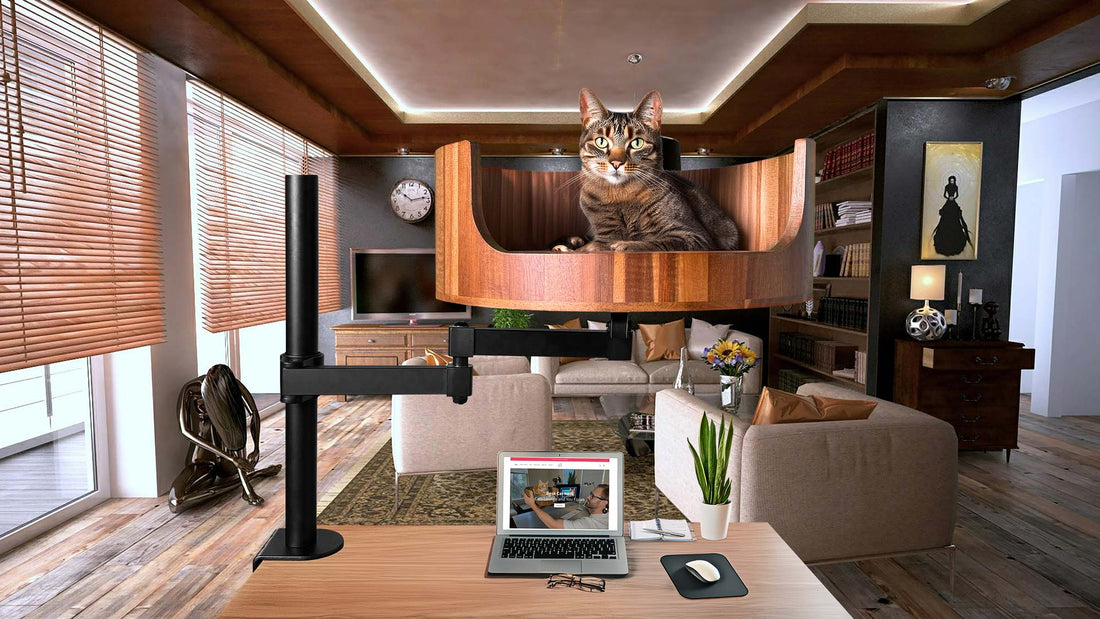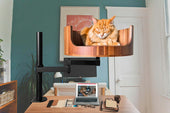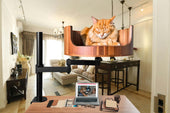
Is My Cat Crying? Understanding Feline Emotions
Share
As cat owners, we've all been there - hearing our beloved feline friends make what sounds like crying noises. But is your cat really crying? Understanding feline emotions can be a tricky task, but with a little insight, you can decode your cat's behavior and provide the best care possible. In this article, we will explore the different ways cats express their emotions, from meowing and purring to body language and vocalizations. By learning to decipher these cues, you can strengthen your bond with your cat and ensure their emotional well-being.
One common behavior that can be mistaken for crying is the notorious "Desk Cat Nest." Cats often create cozy little nests in unexpected places, like on top of desks or shelves, where they can retreat to when they need a quiet space. This behavior is a way for cats to feel safe and secure, especially in busy or stressful environments. By understanding why your cat may be retreating to a Desk Cat Nest, you can provide them with the comfort and support they need to feel at ease. So, next time you hear your cat making what sounds like crying noises, remember that they may just be seeking a little peace and quiet in their own special way.
1. Cats use vocalizations, body language, and behavior to express their emotions, including sadness, anxiety, and physical discomfort.
2. Understanding your cat's individual cues can help you address their needs and improve their overall well-being.
3. Common reasons for cat crying include hunger, stress, loneliness, or health issues that may require veterinary attention.
4. Creating a comfortable and stimulating environment for your cat, such as providing a designated cat nest, can help alleviate emotional distress.
5. Building a strong bond with your cat through play, positive reinforcement, and quality time together can help strengthen your relationship and better interpret their emotional signals.
Understanding Cat Behavior
Cats communicate their emotions through various behaviors, including meowing, purring, hissing, and crying. Understanding these behaviors can help pet owners better interpret their cat's emotional state. For example, cats may cry out when they are in pain, distressed, or seeking attention. It's essential to pay attention to the context of the crying to determine the underlying cause.
Reasons Cats Cry
There are several reasons why a cat may cry, including physical discomfort, stress, hunger, or loneliness. Cats may cry out if they are experiencing health issues such as dental problems, urinary tract infections, or arthritis. Emotional stressors like changes in the environment, new pets, or loud noises can also trigger crying in cats. It's crucial to observe your cat's behavior and consult with a veterinarian to address any underlying health or emotional issues.
Dealing with a Crying Cat
If your cat is crying excessively, it's essential to address the underlying cause to help alleviate their distress. Providing a comfortable and safe environment for your cat, ensuring they have access to food, water, litter box, and toys can help reduce stress and crying behavior. Spending quality time with your cat, playing with them, and providing mental stimulation can also help alleviate loneliness and boredom. If the crying persists, consult with a veterinarian to rule out any potential health issues.
Case Studies
Here are a few examples of how understanding feline emotions and addressing their needs can help reduce crying behavior in cats:
1. Sarah noticed her cat, Mittens, was crying excessively and seemed lethargic. After consulting with a veterinarian, she discovered Mittens had a dental issue that was causing him pain. After receiving treatment, Mittens stopped crying and returned to his usual playful self.
2. John's cat, Whiskers, started crying after they adopted a new kitten. Despite providing plenty of attention and toys, Whiskers continued to cry out of jealousy and stress. By gradually introducing the new kitten to Whiskers and providing separate spaces for each cat, the crying behavior eventually subsided, and both cats learned to coexist peacefully.
Understanding your cat's behavior and emotions can help you provide the best care and support for your feline companion, ultimately leading to a happier and healthier relationship.
Frequently Asked Questions
Why is my cat crying?
There are many reasons why a cat may be crying, including hunger, thirst, boredom, loneliness, pain, or just seeking attention. It's important to observe your cat's behavior and environment to determine the cause of their crying.
Will a Desk Cat Nest help alleviate my cat's crying?
A Desk Cat Nest provides a cozy and secure space for your cat to rest, play, and observe their surroundings. This can help reduce stress and anxiety in your cat, which may lead to less crying.
How can I encourage my cat to use the Desk Cat Nest?
Place the Desk Cat Nest in a quiet and comfortable area where your cat likes to spend time. You can also sprinkle some catnip or treats inside the nest to attract your cat and encourage them to explore and use it.
Is the Desk Cat Nest easy to clean?
Yes, the Desk Cat Nest is made of removable and washable materials, making it easy to clean and maintain. Simply follow the care instructions provided with the product to ensure your cat's nest stays clean and hygienic.
Is the Desk Cat Nest suitable for all cat breeds and sizes?
Yes, the Desk Cat Nest is designed to accommodate cats of all breeds and sizes. The spacious interior and sturdy construction make it a comfortable and safe space for your feline friend to relax and play in.
In conclusion, the Desk Cat Bed is a valuable choice for addressing the issue of a crying cat. With its comfortable and cozy design, this cat bed provides a sense of security and comfort for your feline friend, reducing stress and anxiety that may be causing them to cry. Additionally, the elevated design of the bed allows your cat to observe their surroundings and feel more in control of their environment, further promoting a sense of calmness. Overall, the Desk Cat Bed is a worthwhile investment for both you and your cat, providing numerous benefits to help alleviate their crying and improve their overall well-being.



















































